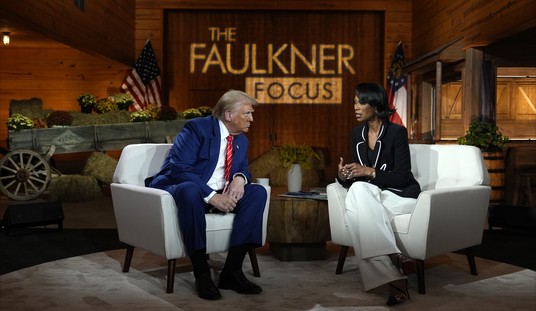A new report out today from The Intercept shows that NIH officials were aware of EcoHealth Alliance conducting banned gain-of-function research experiments. Despite this knowledge, they allowed EcoHealth Alliance to “craft” their own language describing the research they were conducting, exempting themselves from additional oversight. This article confirms months of reporting done here at RedState.
My last several pieces here at RedState have been clear about one thing: EcoHealth Alliance is not to be trusted. When the NIH announced that their determinations regarding the research conducted at the Wuhan Institute of Virology were made solely based on information provided by EcoHealth Alliance, it immediately raised flags for me. EcoHealth Alliance has been funded by numerous government grants from the NIH, the NIAID, USAID, as well as the Department of Defense. Each of these grants has included research done at the Wuhan Insitute of Virology, a Chinese Military-Controlled Lab, further complicating the reliability of the information reported by them.
This latest report from The Intercept leads to an even greater complication: The NIH knew EcoHealth Alliance had conducted gain-of-function experiments and then “adopted language that EcoHealth Alliance crafted to govern its own work.”
In 2016, during the previously discussed White House ordered pause in gain-of-function research, EcoHealth Alliance submitted a grant “progress report” which detailed proposed experiments on SARS and MERS viruses.
From The Intercept:
The plans triggered concerns at NIH. Two staff members — Jenny Greer, a grants management specialist, and Erik Stemmy, a program officer handling coronavirus research — wrote to EcoHealth Alliance to say that the experiments “appear to involve research covered under the pause,” referring to a temporary moratorium on funding for gain-of-function research that would be reasonably anticipated to make MERS and SARS viruses more pathogenic or transmissible in mammals.
This information does two things: 1) It proves that the reporting we have been doing here at RedState has always been correct and factual, and 2) it proves Dr. Anthony Fauci’s multiple statements to Senator Rand Paul and others, to be total and unequivocal lies. Furthermore, the research wasn’t just on mammals, but more specifically on humanized mice. As we have previously discussed, humanized mice are genetically altered so that certain cells within them present the same receptors as human cells, so that researchers can determine if the viruses they are creating, can infect humans. In other words, if these viruses can infect humanized mice, those same viruses could infect humans without any additional genetic alterations.
But what happened next is absolutely terrifying:
Initially, NIH staff appeared intent on enforcing the funding pause. The two administrators requested additional information from EcoHealth Alliance within 15 days and noted that the next round of funding would be withheld until the information was received. They also asked the group to provide a detailed description of changes that would allow the researchers to pursue their aims without conducting the dangerous experiments.
But what happened next sets off alarm bells for biosafety advocates: Agency staff adopted language that EcoHealth Alliance crafted to govern its own work. The agency inserted several sentences into grant materials describing immediate actions the group would take if the viruses they created proved to become more transmissible or disease-causing as the result of the experiments.
Let’s be clear about what happened here. The NIH essentially “caught” EcoHealth Alliance breaking the terms of their grant, but instead of yanking their funding, which should have immediately happened, they allowed for EcoHealth Alliance to draft additional language which allowed them to continue but would require them to notify if they created a more dangerous virus as a portion of their experiments. Not to be forgotten is that the entirety of this research was to be conducted in a Chinese Military Controlled Lab.
The character often at the center of this ongoing scandal is Dr. Peter Daszak, President of EcoHealth Alliance. For months (since at least June 5th), I have been pointing to Daszak as the villain in this story, because whenever a concerted effort to debunk the lab-leak theory emerged, there was Daszak. Daszak has shown there is no low too low, to which he is willing to sink to protect himself from scrutiny. When it came to the potential of EcoHealth Alliance losing the grant in 2016 due to their potentially disqualifying research, Daszak interceded on behalf of his organization in emails obtained by The Intercept:
Daszak responded to the NIH on June 8, 2016, arguing that, because EcoHealth Alliance’s proposed hybrid viruses were significantly different from the SARS virus, which was already known to infect humans, the experiments were not gain-of-function research and should not be restricted.
Daszak also pointed out that the new chimeric SARS-like virus “has never been demonstrated to infect humans or cause human disease,” according to the transcribed emails. And he said that previous research “strongly suggests that the chimeric bat spike/bat backbone viruses should not have enhanced pathogenicity in animals.” The NIH would go on to accept these arguments.
Daszak’s first statement is illogical and doesn’t align with the facts we have at hand. As we know from the definitions covered in previous articles, similarity to other known viruses is not a qualifying factor of gain-of-function research or research conducted under the P3CO Framework. Those rules apply to all viruses and not just those similar to other known deadly pathogens. Daszak then goes on to qualify his research by stating that since the new virus “has never been demonstrated to infect humans,” it doesn’t qualify as gain-of-function. The problem with that is that similar viruses were known to infect the ACE2 cell receptors in humanized mice, which demonstrated it would unequivocally infect humans. Lastly, and probably most importantly, his statement that “research strongly suggests that chimeric bat spike/bat backbone viruses should not have enhanced pathogenicity” is total and complete bovine excrement, and Daszak knows it. Not only is Daszak aware of at least two studies, conducted by Dr. Ralph Baric at UNC, that did that very thing, Daszak, and EcoHealth Alliance funded one of them.
(I have previously pointed out that both of those SARS gain-of-function studies were also funded by the NIH and the NIAID, and were also conducted during the ordered pause and ban on gain-of-function research and funding.)
Yet, the very oversight agency that should have quickly identified Daszak’s comments as misleading manure simply accepted Daszak’s explanation and change to the language of the grant.
In a July 7 letter to EcoHealth Alliance, the NIH’s Greer and Stemmy formally accepted Daszak’s proposed rule. The chimeric viruses were “not reasonably anticipated” to “have enhanced pathogenicity and/or transmissibility in mammals via the respiratory route,” the administrators concluded, according to the transcribed emails.
The language that the NIH later inserted into the grant was strikingly similar to what Daszak proposed: “Should any of the MERS-like or SARS-like chimeras generated under this grant show evidence of enhanced virus growth greater than 1 log over the parental backbone strain you must stop all experiments with these viruses.”
As we now know, that same research resulted in the creation of at least one more virulent virus in 2018, the creation of which EcoHealth Alliance did not report, leading to the NIH demanding additional information about this virus, just last month.
EcoHealth Alliance replied to that demand:
In a letter sent to NIH on October 26, Daszak insisted EcoHealth Alliance did comply with all the requirements of its NIH grant, pointing out that the group reported the results of its experiment in its year four progress report, which it submitted to the agency in April 2018 — and that no one at the agency responded to the description of the experiment. “At no time did program staff indicate to us that this work required further clarification or secondary review,” he wrote.
Daszak also argued in the letter that the viral growth reported in the year four progress report did not correspond to the viral growth outlined in the rule he himself had devised. “The experiment we reported to NIH actually shows genome copies per gram not viral titer.”
Daszak emphasized that the growth of the chimeric viruses in the genetically engineered mice was enhanced only in the early part of the experiment. “By day 6-8, there was no discernably significant difference among the different viral types,” he wrote.
Now to clarify, Daszak is stating that since the NIH did not respond to his progress report submitted in April 2018 (meaning part of the research was conducted before the new Framework was even established), he took that as a license to continue the risky and banned viral research. What’s worse is that he lies about the research, stating that what occurred, which clearly went beyond the language they inserted into the grant, didn’t rise to the level requiring reporting to the NIH.
In the past, you’ve certainly had to trust my reporting (though as we’ve seen, it has been spot-on). Not on this one. On this last assertion, The Intercept wasn’t about to let that go unchallenged and sought out additional experts.
Yet virologists contacted by The Intercept dismissed both the distinction between viral titer and viral growth and the focus on the latter part of the mouse experiment, when the rate of growth between the viruses had evened out.
“I don’t agree with their interpretation,” said Wain-Hobson, of the Pasteur Institute. He described the EcoHealth Alliance’s response as “hairsplitting” and said that viral growth inevitably peters out. “Every growth of a virus comes to a plateau. This has been known since time immemorial,” said Wain-Hobson, who explained that the eventual cessation of viral growth is due to a lack of nutrients. “They have chosen this interpretation because it suits them.”
What does all this mean? It means that was once a conspiracy between EcoHealth Alliance and the NIH to engage in banned viral research has now become a suicide pact between the two organizations, both completely dependent upon the other to survive. What happens to one, will likely happen to the other which is why they both, as well as the leadership of these organizations, continue to lie about the research they funded.
But what it also is, is a total and complete vindication and confirmation of every bit of reporting you have read here at RedState, especially that which you have read since October 20th. I told you on October 20th that the NIH Letter confirmed gain-of-function research, despite their denials. On the 21st, I questioned, “Why is the NIH Still Trusting Peter Daszak?” On the 27th, I pointed out how all of Fauci’s Sunday Morning Talk Show statements were nothing more than clever word origami. On the 29th, I told you how the EcoHealth Alliance work definitively ignored the P3CO framework. On the 30th, I showed you why the EcoHealth Alliance grant was always meant to fund gain-of-function experiments and on the 1st of November, I showed you how research continued outside of the US Government Ban on such. But this morning, the piece that I published asked the following:
First, is that the NIH only provided the progress reports from the 2018-2019 grant period for the EcoHealth Alliance funding. To me, this is an intentional distraction. The 2018-2019 grant period would have been after the HHS had established the new P3CO Framework, thus qualifying Fauci’s statements that it was within that framework, as “true” (for the record, we’ve already proven even then, it wasn’t). The problem with that? The EcoHealth Alliance grant has been running since 2014 as we have reported here. Where are the progress reports for those years? Has the NIH reviewed the experiments they were funding during the US Government Ordered Pause on gain-of-function research? Second, would be why the NIH accepted the EcoHealth Alliance progress report as gospel when the motivation to lie regarding the potential creation of a global pathogen would be so great? And third, is why, even after the ever-growing evidence of a potential lab leak, the proof that Enhanced Potential Pandemic Pathogens were created, the total and complete discrediting of the grant project leader, Peter Daszak, and the Chinese Government’s total and complete refusal to allow for a transparent and independent investigation into the origins of COVID-19, does the NIH continue to fund the EcoHealth Alliance Grant at the Wuhan Institute of Virology?
And then, three hours later, The Intercept publishes the above-mentioned article. We didn’t coordinate and I have never talked to the authors of the Intercept article. Somehow, three short hours after I had asked those questions, their article answers specifically, two of them in damning fashion.
The third, remains unanswered: Why, after everything we still know, are we funding this grant?
Is this the end? No. There’s more, but that’s for tomorrow.













Join the conversation as a VIP Member